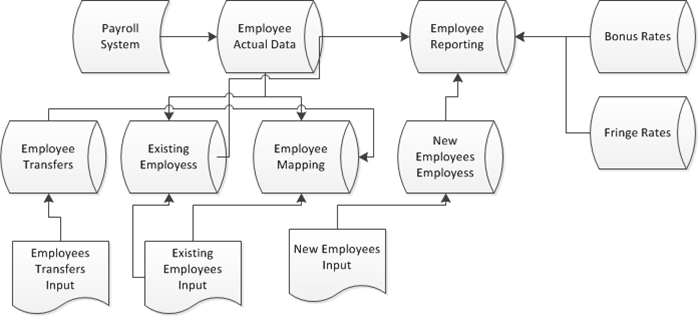You might have missed it if you weren’t closely following the situation or already using the platform, but around the middle of last month IBM forever changed the concept of self-service analytics when they quietly moved Watson Analytics out of beta and into general availability. Watson Analytics is a new cloud-based application that enables an individual to work with their data at a level of ease and intuitiveness that we’ve not seen before. As a sibling of the IBM Watson family, it has inherited a powerful natural language processing capability and as such it enables an individual to query data not with a programming language like SQL, but in the form of a natural language dialogue. Read more
TM1 cubes have now become the OLAP solution of choice for many Cognos BI environments. Because of this emerging trend, there are some techniques and tips that TM1 developers should be familiar with when building a cube for Cognos BI reports. Initially, the Cognos BI platform was built around Transformer OLAP cubes. Transformer cubes are similar to TM1 in many aspects but there are some important structural differences that affect how users consume them in Cognos BI. This article will discuss in detail some of these differences and how to utilize some hidden features of TM1 to build a cube that will mimic the structural features available in Cognos Transformer and make your Cognos BI developer’s job easier. Read more
Synopsis:
Enable a user via a prompt to pre-select if a value will be filtered before or after aggregation.
Overview:
Normally, the report author hard codes filters placed on facts in the Properties pane as before or after aggregation. While this is adequate in most report scenarios, hard coding can be limiting if the executing end-user would like to dynamically choose which aggregation method to use on the fact value at run time. When creating typical reports, this option is not obvious or apparently possible. Read more
Nowadays, anyone from age two to ninety interacts with the internet in some form. Mobile devices have become an increasingly popular means of access. Technology innovations in the form of smartphones and tablets have dramatically changed the way we conduct our daily lives, both in business and personal settings. Because of this societal shift, tools like IBM Cognos Mobile, which delivers rich BI results in the office or on the go, are leading trends in IT. Research studies show that organizations that both prioritize mobile technology initiatives and implement a mobile strategy – not just for IT but across the entire company – are more likely to experience revenue growth and improve IT effectiveness . So with this in mind, what exactly is IBM Cognos Mobile, and what does it offer? Let’s take a quick look. Read more
Difficulty: Easy
Required Ingredients: Report Studio report
Scenario:
You have a highly formatted report in Report Studio and you need a better understanding of how the report is structured. Some of the items in the report maybe hidden and you can’t easily see how things are nested. Luckily, Page Structure view can help with that. Read more
 Ironside is excited to announce a ground breaking new solution for organizations wanting to leverage their analytics workload-optimized PureData for Analytics / Netezza appliance in conjunction with rest of their virtualized private cloud analytics architecture. Ironside’s IBM PureData for Analytics (PDA) for Cloud offering solves all of the major hurdles for connecting your physical big data appliance with your virtual cloud infrastructure: management and communications bandwidth and latency. Ironside is now uniquely able to provide hosting and management of your appliance in conjunction with direct, private, and secure network connectivity back to IBM SoftLayer or other major cloud providers. This means you can host your entire analytics architecture in the cloud and still take advantage of the massive benefits that a physical appliance provides in this application. Read more
Ironside is excited to announce a ground breaking new solution for organizations wanting to leverage their analytics workload-optimized PureData for Analytics / Netezza appliance in conjunction with rest of their virtualized private cloud analytics architecture. Ironside’s IBM PureData for Analytics (PDA) for Cloud offering solves all of the major hurdles for connecting your physical big data appliance with your virtual cloud infrastructure: management and communications bandwidth and latency. Ironside is now uniquely able to provide hosting and management of your appliance in conjunction with direct, private, and secure network connectivity back to IBM SoftLayer or other major cloud providers. This means you can host your entire analytics architecture in the cloud and still take advantage of the massive benefits that a physical appliance provides in this application. Read more
To learn more about Cognos Analytics, the next-generation Cognos platform that IBM announced at Insight 2015, please check out our article on the product’s top 4 release features.
Update, October 6, 2015: Cognos 10.2.2 has been around for almost a year now, and we’ve had a lot of time to dig deeper into the features we discussed originally in this article. To keep you informed on what we’ve found out, this post’s original author Crystal Meyers has gone back and added new reflections and insights she’s gained while working with 10.2.2 in the field. Check out her new thoughts in italics below. Read more
Hospital readmissions are estimated to cost over $41 billion annually. Readmissions, specifically when patients are readmitted within 30 days of discharge, are quality metrics that hospitals watch closely. Healthcare organizations seek to understand what conditions are bringing patients back to the hospital. Many readmissions could be prevented if hospitals can identify the factors that indicate readmission in the patient population. Read more
On October 21st, Ironside hosted Robust Workforce Planning Enablement with IBM Cognos TM1 Webinar, where Ironside’s TM1 experts discussed the challenges and options for cube design and conducted a live demonstration of Ironside’s TM1 workforce planning solution.
Ironside’s planning solutions offer greater capabilities and flexibility than packaged cloud solutions or when compared against other enterprise planning offerings. Read more
Synopsis
This article covers how to allow access to a report with a password challenge prompt, creating a password protected report.
Overview
Security in Cognos is extremely robust, letting you permit or deny access to data elements on a package, data source, or even row level in a Database. Normally, standard group permissions conveniently control report execution access for most situations, but certain business applications may require a select subset of users to run a report who may not all be in the same group. In lieu of adding a separate group and assigning those users to it, a report can start with a prompt page with a password challenge response that allows only users with a valid password to run the report. Read more


